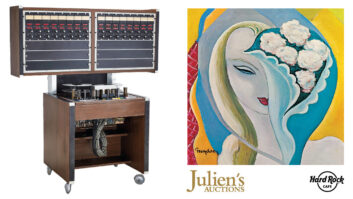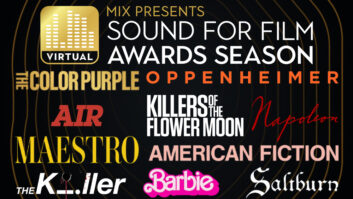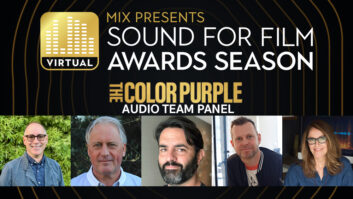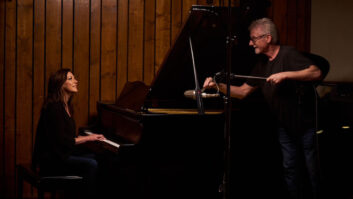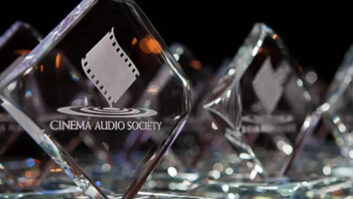The hardest [instruments] to separate are steel and organ, because they end up getting in the same bandwidth a lot. I try to pan them away from each other if I can so they aren’t fighting for the same place in the middle all the time.
Even in the hectic 21st century, the city of Nashville retains its easygoing vibe. In general, people still do talk a little bit more slowly, and there’s an inherent friendliness and courtesy in the way they do business. So, it’s notable that even in this generally laid-back atmosphere, engineer Julian King has developed a reputation as a particularly groovy guy to work with. King’s winning combination of engineering chops and personality has put him behind the board cutting tracks and/or mixing for everyone from superstars like Faith Hill and Tim McGraw to rising stars such as Toby Keith and Jessica Andrews.
King recorded tracks for Hill’s multi-Platinum album Faith and won a Grammy (for Best Country Album) for his work on Hill’s Breathe. He also recorded McGraw’s hit singles “Please Remember Me” and “Don’t Take the Girl,” as well as Toby Keith’s smash album How Do You Like Me Now and Jessica Andrews’ breakthrough, Who I Am.
His body of work also includes tracking and mixes for Brooks & Dunn, Clint Black, Randy Travis, Alabama, John Anderson, Clay Walker and the Neville Brothers, to name just a few.
We caught up with King at Nashville’s Loud Studios, where he was taking a break between mixes for a new Toby Keith release. Initially a bit reluctant (“I don’t think there’s enough to say about me to fill more than a paragraph,” he jokes), his natural friendliness soon asserted itself, and, after a little coaxing, he graciously shared some insights into his engineering style and techniques.
I can tell that you’re a Southerner, but are you originally from Nashville?
No, I’m from Charlottesville, in central Virginia.
Did you start out to be a musician?
Well, I kind of hate to say it out loud, but I started as a trumpet player. [Laughs.] It’s not that I am ashamed of having been a trumpet player. It’s because all I get now about trumpet is, “Daddy, put that away.”
Actually, I did notice a trumpet credit in your discography.
I have only one album credit doing that, but that one album [Charlie Daniels Band’s Simple Man] went Gold in its debut year! Charlie Daniels is such a generous man; he paid my entrance into the musicians’ union so I could play on the one session.
You have a degree in music, though.
Yes, I went to James Madison University. I actually started off as a computer science major, but that only lasted about three-quarters of a semester. I got involved in music things there, and they had a music business program. It was a neat program, but it was simple. They didn’t have a recording studio, but I met people and made some friends, and I found myself doing live sound for bar bands — that sort of stuff. Rich Barnett, my advisor there, set up an internship for me by way of Merlin Littlefield of ASCAP. They got me in with Jimmy Bowen at MCA.
At the time, MCA had a lease on Sound Stage Studios, and Bowen was producing, or overseeing the production, of almost everything on the label. So he had a big staff of engineers and assistants, and I did an internship with them. I guess I fit in with what they were doing, and they agreed to keep a job for me until I finished my last year of school.
There were five or six assistants and seven or eight engineers who did all the records — Reba, George Strait, John Anderson, Lee Greenwood, Waylon Jennings, Vince Gill, Steve Wariner and many others. It was a great place to learn. They used a very structured process, in that it was set up to where engineers were interchangeable. So, frequently you’d be on one project one day and another the next.
That’ll keep you on your toes.
As an assistant, everything had to be very meticulously put together, so when a guy came in the next day who hadn’t been on the session for two weeks, he could pick up and hit the ground running. I worked with some great engineers who I learned a lot from, like John Guess, Chuck Ainlay and Steve Marcantonio.
So is it still true that Nashville tracking sessions go really fast?
Well, I’m told that they go fast, but it’s what I learned on, so I don’t really have a basis to compare.
Typically, we do two three-hour sessions a day. And in those two sessions we’ll cut at least three and maybe four songs. The musicians go from not having heard a note, and with no music notated, to having put together three or four really great pieces of music. I’ve worked with a lot of musicians all over the place; these guys are among the best — everything is improvisation, and it’s amazing.
You’re known for getting a very fat, punchy drum sound.
That’s what I go for. James Stroud, who’s a legendary drummer, is my primary client. He played on all kinds of records — everything from King Floyd’s “Groove Me” and Jean Knight’s “Mr. Big Stuff” to Eddie Rabbit’s “I Love a Rainy Night” and Paul Simon’s “Rhymin’ Simon.” Drumming was his first profession. When your main client is a drummer, you’d better be able to get drum sounds.
You frequently record tracks in The Sanctuary, Ocean Way Nashville’s Studio A.
I love that room. I’ve been lucky to record in a lot of rooms here and in Los Angeles, and while I have several favorites, that’s probably first on my list.
What is your drum setup when you record in that room?
I usually put a FET 47 on the kick drum, and that goes through a module of the big Neve 8078 that they have in there, and I use the Neve 33609 compressor on it and a Pultec EQ. For the snare, I’m pretty boring; I usually just use a [Shure] 57 with an API preamp.
The API because it’s more sharp-edged?
Yes, it’s a little more pointed, a little “crackier.” Then I end up going back to the line-in on the Neve module where I still use the EQ. And usually I’ll put a dbx 160 on that.
You mean the original 160, with VU meters? How might you set that?
I don’t squash the top mic too hard; it hits 2s and 3s at most. And I put another mic under the snare — typically an ATM 35; a little clip-on mic. I put it up close to the snares.
Clipped to a mic stand?
No, I clip it on the snare stand itself, so that if the drummer changes the drum and raises or lowers the stand, the mic chases the drum at the same ratio.
Do you put that bottom mic out of phase?
Yeah, I flop that out of phase and smash the you-know-what out of it with another 160. In fact, you don’t even want to look at that compressor. If the kick drum isn’t triggering the compressor, too, then it’s not smashed enough. Then I add just a little of that sound in, to get a bit of buzz from the snares rattling.
How about the toms?
The toms have the same mics that I put under the snare drum — the ATM 35s. I clip them right on the rim of the toms.
That’s interesting, because your toms don’t sound close-miked.
Those mics are awesome on toms. But don’t print that — nobody else uses them much! They have a fairly tight pattern, and I get them close just trying to get control of the cymbals — so that there’s not so much leakage from the cymbals in the toms. They’re close, pointed pretty much at the middle of the drum, and then I add a little bit of EQ. They don’t require very much, but I end up adding a tiny bit of bottom and taking out a little bit of low middle. No compression on the toms.
What else do you do to make it so live?
My overheads help with the fullness of the toms. Depending on how many cymbals the drummer has, I put up two or three [Neumann] 87s over the cymbals — fairly close.
Do you roll-off the low end on the 87s?
No, I actually end up adding some low end to the overheads. Again, I take out some low middle, in the 200 to 300 area, but I end up adding some down low in the 100Hz area. A lot of times, I’ll put a highpass in so that I don’t end up with some 20Hz trouble. I’ll end up cutting out everything under 30, but I’m boosting some around 100, and that helps fill the toms out. You have to be careful and be sure to audition the phase in several different positions while you are setting it up so that you don’t end up making it smaller rather than bigger.
The room mics are what make the drums great in that room. Ocean Way has a great old pair of Telly [Telefunken] 251s. I put them side by side. Do they call that a coincident pair? They kind of point out — one at the hi-hat and one at the floor tom. It’s not terribly scientific. They’re maybe 10 to 12 feet back and nine or 10 feet high. They’re squashed pretty good, too. I usually put the overheads through my API preamps and [UREI] 1178, and on the room mics, I’ll use a pair of Distressors.
Except for acoustic instruments, the players are in with the drummer, right? How is that set up?
Typically, the bass is direct, although sometimes a speaker is involved. The guitar amps are off in a booth, and we build a big hut around the steel guitar amps that are there in the room, right behind the room mics. The acoustic instruments all have booths — there are lots of booths in that studio.
The typical instrumentation on a tracking session is…
It’s usually a pretty big session, if I’m working with James [Stroud] or with Byron Gallimore. There’s almost always drums, bass, piano — and the piano player usually is Steve Nathan, who brings an organ and a big synth rig in addition to the acoustic piano. Then there’s an acoustic guitar player, two electric guitar players, a steel guitar, plus a fiddle player. That’s eight. Plus the artist, of course.
How long does it take to get set up?
Typically, it takes them a good three or four hours to get it all put together. Just because there are so many bodies that come in the door. [Laughs.] The cartage parade alone is lengthy. Usually by the time I get there, they’ve got it all set up and they’ve phase-popped everything.
Speaking of setting up, I’d like to mention that I have five guys and gals in town who I work with a lot who are really the bomb. I am really cranky without them. There’s Ricky Cobble, who I have been working with for a long time; Rich Hanson and Jake Burns at Loud; and David Bryant and Leslie Richter at Ocean Way. They all do a great job. When I have an idea in my mind, I look up and they’re already plugging it in. I get to work in a lot of places all over the country, and if one of them doesn’t go with me, it’s much harder for me.
One of those five leaked to me that you like to use Gefell UM 70S mics on acoustic guitar.
I got that from Lynn Peterzell, who was my primary engineering influence. He was my mentor and I was his assistant. He started me on that mic, which has a really sweet midrange without being hard. I’ve heard people use them on piano, but I like them on acoustic guitars.
You also often take a direct out on acoustics.
If the guitar has one, I take it. It’s a texture I wouldn’t otherwise have that gives me a choice later. I may do something to it, like split it through Amp Farm and kind of bury it, or maybe put it way out on the edge where it just sounds like a dull double. It has a different dynamic characteristic; it’s much less dynamic than the mic, obviously, so with regard to the level of the mic, which kind of goes up and down, the direct holds a more constant path. So if the acoustic goes soft on the mic, it may poke out a little more on the direct. And if you pan them away from each other, it kind of makes it move in the stereo image. That all being said, sometimes I don’t use it at all!
But, one place in particular you can hear that kind of sound is in the beginning of “Breathe.” Mike Shipley, who did the mix, used it panned out on the edge, and it sounds like there are two guitars playing two parts — you can feel it pulse left to right.
How do you record piano?
I carry a pair of Audio-Technica 4050s, and I have a pair of Calrec RQP 3200 modules that were Lynn Peterzell’s. They have a mic pre, a line-in, an EQ and a compressor, all in one module. I love them on piano. They’re very hard to find; I’ve tried to rent them out in L.A., and nobody has them. Ricky or I end up carrying them out there when we work with Clint Black or do movie stuff.
Generally I use three mics: The two A-Ts close up over the hammers, low and high, and then I put an 87 back in the middle of the piano, pointed up at the hammers. I add just a little of that to fill in the middle. I set it, for lack of a better description, right over the ass of the piano. And, rather than pointed down at the strings, it’s kind of pointed up like it’s looking right at middle “C.” I use a little bit of that, because sometimes piano gets “phase-y” when you put stereo mics over the hammers. If you add a little bit of that to fill the middle back in, it doesn’t vanish if they are playing something in the middle of the piano. I compress that with a pair of the Neve compressors that are in the console — I can’t remember the model. [Laughs.] The little in-line guys everybody wants.
You’ve been mixing on the Sony Oxford console a lot lately.
I prefer to mix on the Oxford, absolutely. When James [Stroud], Blake [Chancey] and Paul [Worley] told me they were putting it in here at Loud, I didn’t want anything to do with it. George Massenburg calmed me down by spending a little time with me right at the beginning, and the more I got into it, the more musical it became to me. The automation works perfectly — it’s so simple. It doesn’t look like a regular console: People walk in and say, “Oh my gosh, I don’t want to learn that thing.” [Laughs.] But I’d really just as soon they not come and learn it, because then they’ll be working in here and I won’t be able to get in!
What about the learning curve?
Once you understand the simplicity of it, it’s not a problem. You get a good snapshot set up or have a good starting point on the console, and it’s awesome. You can automate anything. If you want an EQ sweep, or if you want an EQ to pop out, you can set two EQ curves on any EQ and it has an A/B switch that you can automate. Which is great if you have a soft-textured verse of a song and you want to make a little different EQ for the verse without having to set up a completely separate module.
The automation and recall are the best, and that’s a real asset, particularly with some of the producers I work with who wear a lot of hats. Several of the prime producers here in Nashville are also label heads; they have to do all the things involved with that, plus make records, so their time is really at a premium. With the Oxford, I can mix for a series of days, and since I have total recall ability, they don’t have to be here. I can mix five songs, then they can come back for a day and we can close all five of those songs together in a day. It’s also great for artists who tour a lot, for the same reasons.
You’ve been doing some producing yourself lately.
Here and there. I’m so busy engineering that there’s not a lot of time. But there’s a band I’ve been co-producing with James Stroud on Dreamworks called Emerson Drive, a very talented bunch of young guys from Canada who I’m really excited about. They played every note on the record themselves, which doesn’t happen with too many groups out of Nashville. It’s a six-piece band: electric guitar, a keyboard player, bass player, drummer, a singer and a fiddle.
Oh, I forgot to ask you how you mike fiddle. You know, we don’t get that many fiddle players out in L.A.
Big vintage mics sound great on fiddles, like a [Neumann] 49 or a 47. We tried one of the Neumann 249s — the new version of the M49 — the other day and loved that.
Do you put it close?
Fairly close; maybe eight inches. Most of the guys work the mic a little bit depending on the part they are playing. When I’m working at Ocean Way, it goes through the console, but I use a Distressor and a Pultec. I take a little bit of 5k out and add a little bit of 10k.
With all those players, what do you do to help give them each their own space in the track?
The hardest ones to separate are steel and organ, because they end up getting in the same bandwidth a lot. It can be tough to separate them sometimes. I try to pan them away from each other if I can so they aren’t fighting for the same place in the middle all the time. And, hopefully, there are some subtle EQ adjustments you can make from one to the other, on a song by song basis, to try and make them fit.
Do you tend to filter more or add EQ?
I end up doing some of both. The FET 47 [on the kick], for instance, has got a lot of low end. I end up filtering way down low and even taking out some more at 30 Hz. I’ll put a filter at 20 and then take out more at 30, and then I’m bumping up at 100 a little so I can get it to thump, but not blow the woofers right out. And I end up taking out a fair amount at 300, to try and get the “awnk” out of it. [Laughs.] How are you going to spell “awnk”?
Are you a Pro Tools user?
User and owner. In fact, the last several albums I’ve mixed have been straight out of Pro Tools. I like to get the color on tape during recording, then I dump all the tracks right into Pro Tools. It gives me more manipulative power later. I can stick Amp Farm on a mandolin and stuff like that. You can come up with a texture you might not otherwise have that’s cool or a little more modern-sounding or something wacky. Or you may decide that what somebody played in the second chorus is better than what they played in the first and you can move it. It’s great for doing mutes and things on toms so you can get control of the leakage. I do a volume graph and just turn the toms on when they’re playing, so you can get it really tight but really smooth. It’s not a linear “off.” You can do little fade ups and outs so they don’t sound so abrupt.
But you still track to a Sony 3348.
Yes, and after the tracks, I go digital through the Euphonix 727, which is a wonderful box. It’s a format converter, and it removes the need for having 888s if you’re working in the digital world. So I just plug my computer into the 727 and it spits a MADI word right out to the Sony console. I go “dig” straight from a Pro Tools rig, without 888s, to the 727, straight to the Oxford.
What’s your favorite new piece of gear?
Right now, I’d have to say it’s the new computer I got for my Pro Tools rig. I’d been nursing along this sorry old 9500 computer for way too long. Now I’ve got a G4 466. So, short term, that’s my favorite new piece. Long term, I guess it is the Oxford! I also switched to KRK E8 speakers and really love them. Chuck [Ainlay] turned us on to those, as well as the big ATC monitors at Loud — they rock!
I know you have to get back to work, but tell us what’s up next on your schedule?
The big thing on my calendar is a trip to Disney World and the beach with my wife and children. They pay a high price so that I can do a job I love. I know a trip won’t get all those late nights and weekends back, but we sure will have a blast in Orlando! As far as the studio schedule goes, I hope to be working on a new Faith Hill album before long. We’ve not scheduled anything with her yet, but recording with Faith is always great. I hate to take on too much more, but if the right production opportunity came along, I would likely take it!
Maureen Droney is Mix‘s L.A. editor.
JULIAN KING: SELECTED CREDITS
E: Engineering; M: Mixing; R: Recording
John Anderson: Paradise (1996, E)
Jessica Andrews: Who I Am (2001, E)
Clint Black: Nothin’ But the Taillights (1997, E/M); One Emotion (1994, E)
Brooks & Dunn: Tight Rope (1999, E/M)
Carlene Carter: Hindsight 20/20 (1996, E)
Billy Gilman: Classic Christmas (2000, M)
Faith Hill: Breathe (1999, E/R); Faith (1998, E)
Tim McGraw: Set This Circus Down (2001, E/String)
Jo Dee Messina: Burn (2000, E)
Randy Travis: Man Ain’t Made of Stone (1999, E/M)
Travis Tritt: Country Club (1990, E)
Various: Songs of Jimmie Rodgers: A Tribute (1997, E)
Various: Tribute To Tradition (1998, E)
